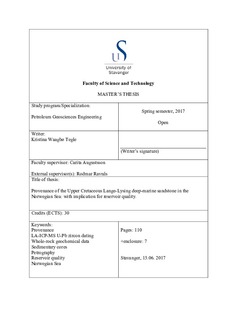| dc.contributor.advisor | Augustsson, Carita | |
| dc.contributor.advisor | Ravnås, Rodmar | |
| dc.contributor.author | Tegle, Kristina Waagbø | |
| dc.coverage.spatial | Norway | nb_NO |
| dc.date.accessioned | 2017-11-07T09:45:32Z | |
| dc.date.available | 2017-11-07T09:45:32Z | |
| dc.date.issued | 2017-06 | |
| dc.identifier.uri | http://hdl.handle.net/11250/2464518 | |
| dc.description | Master's thesis in Petroleum Geosciences Engineering | nb_NO |
| dc.description.abstract | The provenance and reservoir properties of Upper Cretaceous Lange-Lysing sandstone in the Norwegian Sea have been determined by using integrated whole-rock geochemical, petrographic and detrital zircon U-Pb age dating by LA- ICP-MS. Three different provenance signatures are revealed within three geographical areas containing the Lange-Lysing succession. They have contributed to significant response on diagenesis, which gives implication for reservoir properties, whereby the petrographic data expose several controls on porosity development, including textural and mineralogical factors. (1) Quartzofeldspathic petrofacies in the Møre Margin are interpreted to have the highest potential as hydrocarbon reservoir due to better sorting and larger grain size, combined with preservation of intergranular and intragranular porosity, not occluded by cement. The zircon grains were derived from felsic sources in the Western Gneiss Region of Baltica, due to a prominent age peak that closely corresponds with the Sveoconorwegian (1000-950 Ma) and the Gothian orogenies (1700-1500 Ma). (2) Sandstone of the quartzolithic petrofacies from the Halten-Dønna Terrace has smaller grain size and is less sorted than the quartzofeldspathic petrofacies, yielding a lower reservoir quality. The detritus is suggested to have been sourced from more mixed ?andesitic-felsic rocks. The zircon grains derived from the Paleozoic Caledonian Nappe Domain of western Baltica and from the Lofoten Islands or Western Tromsø Basement Complex in northern Norway because of a dominance of Early Proterozoic crust-forming zircon grains (1800-1750 Ma) and an Archean component. (3) The main diagenetic features of the quartzarenitic petrofacies in the deeper Vøring Basin includes mechanical and chemical compaction, precipitation and replacement of quartz overgrowth, kaolinite, clay minerals, iron oxide and formation of secondary porosity due to dissolution of labile minerals. Grain coating of authigenic clay minerals exerts a critical control on the reservoir quality as it inhibits quartz cement. The deposits are inferred to have mixed sand distribution from the eastern Greenland and the Norwegian margins based on wide zircon-age spectra with predominance of Early Proterozoic (1900-2100 Ma) and Archean contribution (>2600 Ma). Contradictory to previous studies, the U-Pb analysis of the Lange-Lysing sandstone has proved that Late Archean zircon is present within deposits derived from the Norwegian landmass. Furthermore, the study stresses a strong correlation between provenance, diagenetic products and reservoir quality | nb_NO |
| dc.language.iso | eng | nb_NO |
| dc.publisher | University of Stavanger, Norway | nb_NO |
| dc.relation.ispartofseries | Masteroppgave/UIS-TN-IPT/2017; | |
| dc.subject | petroleumsteknologi | nb_NO |
| dc.subject | petroleum engineering | nb_NO |
| dc.subject | provenance | nb_NO |
| dc.subject | petroleumsgeologi | nb_NO |
| dc.subject | geochemical data | nb_NO |
| dc.subject | sedimentary cores | nb_NO |
| dc.subject | petrography | nb_NO |
| dc.title | Provenance of the Upper Cretaceous Lange-Lysing deep-marine sandstone in the Norwegian Sea: with implication for reservoir quality. | nb_NO |
| dc.type | Master thesis | nb_NO |
| dc.subject.nsi | VDP::Teknologi: 500::Berg‑ og petroleumsfag: 510::Geoteknikk: 513 | nb_NO |
| dc.subject.nsi | VDP::Matematikk og Naturvitenskap: 400::Geofag: 450::Petroleumsgeologi og -geofysikk: 464 | nb_NO |
